See also
- Banca Pueyo, traditional Spanish bank
| This disambiguation page lists articles associated with the title Pueyo. If an internal link led you here, you may wish to change the link to point directly to the intended article. |
Pueyo may refer to:
| This disambiguation page lists articles associated with the title Pueyo. If an internal link led you here, you may wish to change the link to point directly to the intended article. |
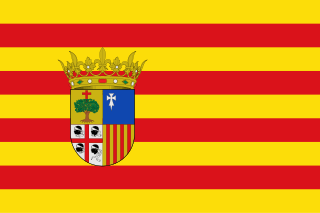
Aragon is an autonomous community in Spain, coextensive with the medieval Kingdom of Aragon. Located in northeastern Spain, the Aragonese autonomous community comprises three provinces : Huesca, Zaragoza, and Teruel. Its capital is Zaragoza. The current Statute of Autonomy declares Aragon a historic nationality of Spain.

Huesca is a city in north-eastern Spain, within the autonomous community of Aragon. It is also the capital of the Spanish province of the same name and of the comarca of Hoya de Huesca. In 2009 it had a population of 52,059, almost a quarter of the total population of the province. The city is one of the smallest provincial capitals in Spain.
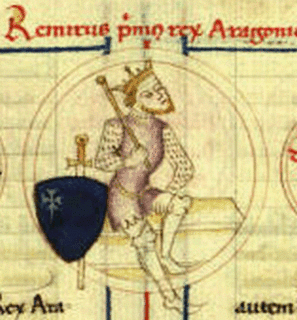
Ramiro I was the first King of Aragon from 1035 until his death. Apparently born before 1007, he was the illegitimate son of Sancho III of Pamplona by his mistress Sancha of Aybar. Ramiro was reputed to have been adopted by his father's wife Muniadona after he was the only one of his father's children to come to her aid when needed, although there is no surviving record of these events and the story is probably apocryphal.
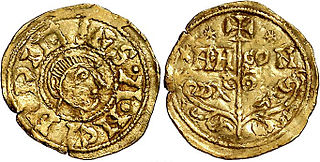
Sancho Ramírez was King of Aragon from 1063 until 1094 and King of Pamplona from 1076 under the name of Sancho V. He was the eldest son of Ramiro I and Ermesinda of Bigorre. His father was the first king of Aragon and an illegitimate son of Sancho III of Pamplona. He inherited the Aragonese crown from his father in 1063. Sancho Ramírez was chosen king of Pamplona by Navarrese noblemen after Sancho IV was murdered by his siblings.

Huesca, officially Huesca/Uesca, is a province of northeastern Spain, in northern Aragon. The capital is Huesca.

Zaragoza, also called Saragossa in English, is a province of northern Spain, in the central part of the autonomous community of Aragon. Its capital is Zaragoza, which is also the capital of the autonomous community. Other towns in Zaragoza include Calatayud, Borja, La Almunia de Doña Godina, Ejea de los Caballeros and Tarazona.

The Roman Catholic Diocese of Barbastro-Monzón is located in north-eastern Spain, in the province of Huesca, part of the autonomous community of Aragón. The diocese forms part of the ecclesiastical province of Zaragoza (province), and is thus suffragan to the Archdiocese of Zaragoza.

The monastery of San Juan de la Peña is a religious complex in the town of Santa Cruz de la Serós, at the south-west of Jaca, in the province of Huesca, Spain. It was one of the most important monasteries in Aragon in the Middle Ages. Its two-level church is partially carved in the stone of the great cliff that overhangs the foundation. San Juan de la Peña means "Saint John of the Cliff".

Santa Cruz de la Serós is a village in the province of Huesca, Aragon, Spain. Located 88 kilometers from the city of Huesca, it is located at a hill side on the way to the Monastery of San Juan de la Peña.
Casbas de Huesca is a municipality located in the province of Huesca, Aragon, Spain. According to the 2004 census (INE), the municipality has a population of 296 inhabitants.

El Pueyo de Araguás is a municipality located in the province of Huesca, Aragon, Spain. According to the 2018 census (INE), the municipality has a population of 154 inhabitants.
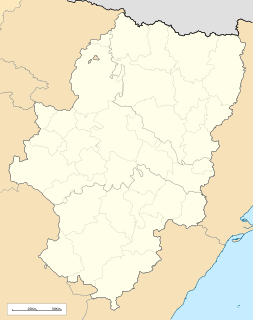
Pueyo de Santa Cruz is a municipality located in the province of Huesca, Aragon, Spain. According to the 2004 census (INE), the municipality has a population of 330 inhabitants.

Villadoz is a municipality located in the province of Zaragoza, Aragon, Spain. According to the 2010 census, the municipality has a population of 83 inhabitants.
Castejón may refer to:

Ribera de Queiles is a Spanish geographical indication for Vino de la Tierra wines located in the province of Zaragoza and in the southern part of Navarre. Vino de la Tierra is one step below the mainstream Denominación de Origen indication on the Spanish wine quality ladder.

Fortún Garcés Cajal was a Navarro-Aragonese nobleman and statesman, perhaps "the greatest noble of Alfonso the Battler's reign". He was very wealthy in both land and money, and could raise two to three hundred knights for his retinue, funded both out of his treasury and enfeoffed on his lands.

La Jacetania is a comarca in northern Aragon, Spain. It is located in the northwestern corner of the Huesca and Zaragoza provinces. The administrative capital is Jaca, with 13,374 inhabitants the largest town of the comarca. The area is famous for its ski resorts.
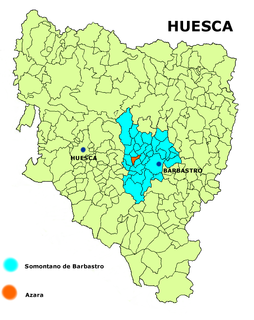
Azara is a municipality in the province of Huesca, Spain. In 2018, it had a population of 174 inhabitants. It is located in the middle of a valley named after Alferche, to the right of the La Clamor Canyon, surrounded by sandstone the highest among which is Peña de Santa Margarita, 40 km away from Huesca.
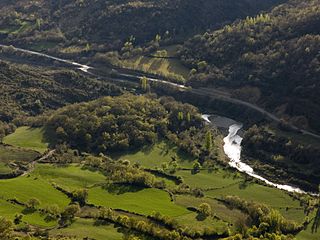
Beranuy, in Ribagorçan and Aragonese: Beranui is a municipality located in the Ribagorza (comarca) comarca, province of Huesca, Aragon, Spain. According to the 2010 census (INE), the municipality has a population of 104 inhabitants.

Sancho Sánchez was an important magnate of the Kingdom of Aragon in the late 11th and early 12th centuries, during the reigns of Sancho Ramírez, Peter I and Alfonso I. He was governor of the important Navarrese tenancies of Erro, the castle of San Esteban de Deyo (1084), the capital city of Pamplona (1092), Aibar and Tafalla (1098) and Falces and Leguín (1112). In Aragon proper, he governed the important fortress of El Castellar overlooking Muslim Zaragoza from 1091 and the town of Ejea from 1113. He held the rank of count from 1085, before that he was a lord (senior).